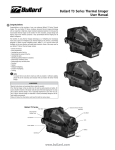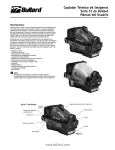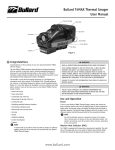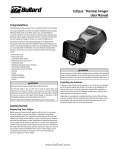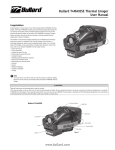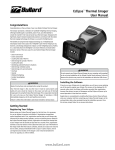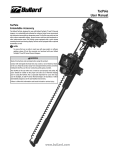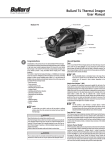Download Bullard T3 Series Thermal Imager User Manual www.bullard.com
Transcript
Bullard T3 Series Thermal Imager User Manual Congratulations Congratulations on the purchase of your new advanced Bullard T3 Series Thermal Imager. The new Bullard T3 Series combines advanced thermal imaging technology with our expertise in high heat, impact resistant engineered polymers to bring you the most durable thermal imager on the market. The T3’s innovative, compact design and logical, easy-to-use interface presents a truly personalized thermal imaging tool to today’s firefighters. The benefits of using thermal imaging technology as a firefighting tool encompass nearly every aspect of a firefighter’s job. Thermal imaging is not, however, a technology designed to replace current firefighting tactics. Rather, it is a tool that allows the firefighter to be more effective and make better decisions. Some of the many uses for your Bullard T3 Series Thermal Imager include: • Search and rescue • Scene assessment • Locating the seat of the fire • Determining the spread of the fire • Locating hot spots • Identifying potential flashover situations • Determining ventilation points • Determining entry and exit points • Overhaul • Hazmat • Wildland firefighting • Incident investigating • Training Note To ensure that we are able to reach you with any product or software updates, please fill out the warranty card enclosed with your Bullard T3 Series Thermal Imager. Warning Read all instructions and warnings before using this product. Your thermal imager is like any other tool. It must be used properly and safely. All users should be trained on the proper and safe use of thermal imaging prior to using the T3 Series Thermal Imager. This is especially important for users who may use the T3 Series Thermal Imager in hazardous or IDLH (immediately dangerous to life and health) environments. Failure to follow this information could result in death or serious injury. Bullard T3 Series Rear Boot Electronic Thermal Throttle (optional) Polycarbonate Display Cover Lens Bezel LCD Screen Lens Power Button Battery Side Strap Figure 1 www.bullard.com Use and Operation Power To turn on your Bullard T3 Series Thermal Imager, depress and release the large, dark gray power button under the LCD display (Figure 2). Upon pressing the power button the thermal imager will display the Bullard logo and initiate a calibration sequence. The thermal image will appear in approximately 5 seconds. To turn off power, depress and Power Button release the power button again. Figure 2 Note You will periodically observe a momentary freeze in the image. This is normal and is a function of the self calibration shutter. The shutter will activate every 30 seconds to three minutes, depending on the environment. Relative Heat Indicator™ (RHI) The T3 Series is equipped with temperature measurement capability. The right side of the display will show a bar graph or Relative Heat Indicator (RHI). The RHI will indicate the approximate temperature of the object viewed within the “crosshairs” shown in the middle of the screen. The accuracy of the indicators is dependent on numerous factors including the distance from the object being viewed and its emissivity, which is the object’s ability to radiate heat. Units are calibrated with a preset emissivity corresponding with normal construction materials. Objects with emissivities that vary greatly from this, such as metals and shiny objects, will reduce the accuracy of the temperature indication. Additionally, temperature measurement accuracy decreases as the distance from the object in the “crosshairs” increases. NOTE The RHI provides a quick reference to compare objects of similar emissivities to serve as a guide to pinpoint intense heat sources. Due to the inherent issues with accuracy, use this feature with caution and verify indicated heat levels through traditional means whenever possible. Super Red Hot™ Feature The T3 Series features Super Red Hot high heat colorization. With the Super Red Hot feature, heat levels are identified by various color hues. Starting at 500 degrees, heated objects are tinted yellow and gradually transition to orange and then solid red as heat levels rise. The Super Red Hot feature identifies specific heat layers alerting firefighters to areas of intense heat. This feature provides an enhanced visual awareness of the hottest objects in a scene. Electronic Thermal Throttle™ Your T3 Series Thermal Imager may be equipped with Electronic Thermal Throttle (ETT), a highly useful and Figure 3 unique feature available on Bullard firefighting Thermal Imagers. The ETT is ideal for pinpointing hot spots during overhaul, searching for overheated electrical equipment, or clarifying objects in ambient temperature situations. To activate the ETT option, locate the two black buttons on top of the unit. Press the down button (the button closer to the front of the imager) to activate the ETT (Figure 3). The ETT will automatically sense the hottest area in the scene and color it blue. Continuing to press the down button (or holding it down) will further engage ETT and will color more of the scene blue, eventually coloring even the coolest objects blue. Note Using the Battery Charger The battery should be charged in the battery charger using either the AC or DC adapter provided (Figure 4).To charge a battery, insert it into the charger so that the metal contacts on the battery are aligned with the metal contacts in the charger. A red light will illuminate on the charger to indicate that the battery is charging. When the light on the charger turns to green, the battery is fully charged. You may leave the battery in the charger indefinitely as the battery will not overcharge and the charger will initiate a trickle charge to maintain the battery’s charge. For maximum battery life and performance, you should remove the battery from the charger and discharge it completely on a monthly basis. Note If you do not see the red LED illuminate when you place a battery into the charger, the battery is not charging. Loading/Unloading the Battery Loading and unloading the battery on the Bullard T3 Series is straightforward (Figure 5). To install a battery, slide the battery into the groove on the bottom of the unit and ensure that the battery is properly seated. To remove a battery, depress both battery locking buttons simultaneously and slide the battery out of the unit. Since it can only be loaded one way, the battery is easily replaced in the dark. Additionally, as with all batteries, your Bullard rechargeable battery will experience a slow drain of its charge during storage. The amount of drain varies widely based on storage conditions. For best performance, charge each of your batteries every two weeks. Figure 5 Battery Locking Buttons Warning Do not allow the metal contacts on the label side of the battery to come in contact with a conductive surface, such as a metal table or another battery. This can complete the battery circuit and cause the battery to overheat or melt. Failure to observe this warning may result in permanent battery damage, property damage and/or serious injury. Note Fully charged NiMH batteries will provide a run time of 2 1⁄2 hours. This run time will be less in extreme heat or extreme cold conditions and/or if the transmitter is in use. To extend the potential lifespan of your batteries, fully drain and recharge each battery monthly. To help extend the life of the rechargeable batteries and prevent unexpected instances of uncharged batteries, develop a clear formalized plan for maintaining, charging, and replacing your batteries. B ullard provides an optional AA Alkaline battery case which can be used as an alternative to the standard 10 V NiMH rechargeable batteries. The AA alkaline battery case requires eight AA alkaline batteries. Once the batteries are installed, the case loads into the unit in the same manner as the standard NiMH battery. Due to the unique way that alkaline batteries disperse power to the unit, the LED indicators will report battery levels that are not necessarily indicative of the battery’s actual remaining charge. Fully charged AA Alkaline batteries will typically operate a Bullard T3 Series Thermal Imager for 2 hours. Do not insert the AA Alkaline battery case into any Bullard T3 Series battery chargers, including the Powerhouse. As the throttle engages more of the scene, the blue will become lighter in hue to help differentiate objects in the scene. As you cycle through the scene, you’ll see the symbol “TT” and a corresponding number in the bottom left hand corner of the display. The “TT” indicates “Thermal Throttle” mode. The number (0-100) is a point of reference to indicate the level of Thermal Throttle engagement; by itself it has no specific meaning. Most of the benefits of the ETT are accomplished with the first few presses of the button. To deactivate the ETT or lessen the amount of blue in the scene, press (or hold) the right side of the cover, which is the right button on the throttle. Alternatively, you can quickly deactivate the ETT, by pressing both buttons simultaneously for one second or turning off the Eclipse and turning it back on. Figure 4 Note The Electronic Thermal Throttle takes approximately eight seconds to calibrate from the initial startup of the thermal imager. During this short period, the ETT will not engage. www.bullard.com Bullard T3 Series Thermal Imager User Manual Warning CAUTION The T3 Series thermal imagers are extremely sensitive to intense, radiant light. Never point the T3 Series thermal imagers at the sun or any other source of extreme radiant light, as this could severely damage the thermal imager. Do not use solvents or paint thinners to clean your Bullard T3 Series Thermal Imager as they could permanently mar the surface or degrade the protective properties of the casing. Do not intentionally submerge the unit underwater or subject the unit to high pressure water. Follow care instructions described above. Failure to observe these instructions may result in product damage. Any damage caused by improper care is not covered under warranty. Strap Assemblies Side Straps The side straps are designed to be field replaceable. Users can order replacements and install them without having to return the thermal imager to the factory. Removing/Installing the Side Straps To remove either of the right or left side straps, loosen the strap and pull it through the strap loop located on either side of the LCD display (Figure 6). Remove the screw that holds the strap to the imager. To install, fasten the strap to the unit using the screw provided. Do not overtighten. Feed the strap through the strap loop and adjust to the desired length. Warning Strap Loop Do not attempt to disassemble the Bullard T3 Series Thermal Imager. If the unit is not functioning promptly return it to Bullard for evaluation. Disassembling the unit voids all warranties. Like all thermal imagers sold at the time of this printing, the Bullard T3 Series is not certified as intrinsically safe. Thermal Imaging is not a technology designed to replace current fire fighting tactics. Rather, it is a tool that allows the firefighter to be more effective and to make better decisions. Firefighters cannot stop using basic firefighter safety tactics. All firefighters should receive proper training on: how thermal imagers work; the uses and limitations of thermal imagers; image interpretation; and the safety considerations for thermal imaging use. Do not attempt to remove the lens gasket or the rear boot. These parts provide sealing and removal will break the seal exposing the unit to potential water damage. Failure to follow these instructions could result in death, serious injury and/or product damage. Side Strap Figure 6 Adjusting the Side Straps To adjust a side strap, loosen the hook and loop and set to the desired length. Combination Strap The combination strap (Figure 7) can be used either as a wrist strap to keep the imager from falling if it should slip from your hand, or as a gear strap, hooked directly onto your turnout gear or SCBA. As a wrist strap, the adjustable strap fits over the sleeve of your turnout gear and can adjust to any size wrist. The strap can be easily attached to either D-ring located on the thermal imager. As a gear strap, the strap can be attached to a D-ring on your turnout gear or SCBA and to a D-ring on the thermal imager. A quick release buckle serves as a safety release mechanism in case the thermal imager ever becomes lodged inhibiting movement. Simply depress the buckle and the thermal imager releases from the strap. Figure 7 Care Instructions The Bullard T3 Series Thermal Imager requires little maintenance. For best results, after each use: • Clean the outside of the unit with mild soap or detergent. • Wipe the lens with a soft cloth. • Clean the display with a soft cloth. • Check screw tightness on side straps and cover display • Store your thermal imager in the optional truck mount or in the delivery case provided. • All thermal imagers should be maintained using a proper program. Cleaning the Lens The Bullard T3 Series lens is recessed in an impact resistant bezel. The lens can be cleaned with a soft cloth and soapy water as required. Replacing the Video Display Cover Window The display cover (Figure 8) has a scratch resistant hard coating to minimize marring. However, if heavy scratching or gouging does occur, the cover window can be replaced. To do this, simply remove the four screws along the top and bottom of the window. Remove the plastic display cover window and replace with a new one (part number T3WINDOW) making sure that the countersink slots around the mounting holes are facing Figure 8 outward. Do not overtighten. Service If your Bullard Thermal Imager is not performing properly, please contact Bullard Customer Service at 877-BULLARD (285-5273). Outside the US & Canada, call 1-859-234-6611. Describe the problem to the Bullard representative as completely as possible. For your convenience, your representative will try to help you diagnose or correct the problem over the phone. Before returning your Bullard thermal imager, you should verify with your representative that the product should be returned to Bullard. Bullard Customer Service will provide you with written permission and a return authorization number. If the return is a non-warranty repair, a Bullard Customer Service Representative or your local distributor will provide you with a repair invoice estimate. To authorize repair, you must provide a purchase order to your distributor for the amount of the estimate. Once Bullard receives authorization from your local distributor, we will issue you a return authorization number so that you can return the unit to Bullard. Bullard will repair the unit and ship it from our factory within 48 business hours. If the cost of repairs exceeds the stated quote by more than 15% or by more than $100, a Bullard representative will reestimate your repair and your local distributor will contact you for authorization to complete repairs. After repairs are completed and the goods have been returned to you, your distributor will invoice you for the actual repair amount. NOTE Do not attempt to disassemble the sealed case of your Bullard T3 Series Thermal Imager. If the unit is not functioning properly, return it to Bullard (as described in the Service section) for evaluation. Disassembling the unit voids all warranties. Decontaminate and clean your Thermal Imager to remove any hazardous or contaminated materials that may have settled on the product during use. Laws and/or shipping regulations prohibit the shipment of hazardous or contaminated materials. Products suspected of contamination will be professionally decontaminated at the customer’s expense. Returned products will be inspected upon return to the Bullard facility. If the repair is under warranty, Bullard will repair the unit and ship it from our factory within 48 business hours. www.bullard.com Warranty Bullard warrants to the original purchaser that the Bullard T3 Series and all features/accessories installed in the unit are free of defects in materials and workmanship under intended use and service for a period of one (1) year from date of manufacture. Bullard’s obligation under this warranty is limited to repairing or replacing, at Bullard’s option, articles that are returned within the warranty period and that, after examination, are shown to Bullard’s satisfaction to be defective, subject to the following limitations: a) Article must be returned to Bullard with shipping charges prepaid. b) Article must not be altered from its original configuration. c) Article must not have been misused, abused, or damaged in transport. d) Maintenance and field replaceable items, if defective, are covered under warranty for a ninety (90) day period. These items include: • Batteries • Straps • Display covers • AC/DC adapters • All accessories except transmitters, receivers and chargers Bullard provides a limited lifetime warranty on the T3 Series outer shell. This warrants that the outer shell is free of defects in materials and workmanship under intended use and service for the original purchaser. Bullard’s obligation under this warranty is limited to repairing or replacing, at Bullard’s option, articles that after examination are shown to Bullard’s satisfaction to be defective, subject to the following limitations: 1. Article must not be altered from its original configuration. 2. Article must not have been misused, abused, or damaged in transport. 3. When the outer shell is obsolete and Bullard no longer stocks the part, the limited lifetime warranty will be terminated. In no event shall Bullard be responsible for damages, loss of use, or other indirect, incidental, consequential or special costs, expenses or damages incurred by the purchaser, notwithstanding that Bullard has been advised of the possibility of such damages. Any implied warranties, including warranties of merchantability and fitness for a particular purpose, are limited in duration to one (1) year from the date of manufacture of this. Some states do not allow the exclusion or limitation of incidental or consequential damages, or allow limitations on how long an implied warranty lasts, so the above limitations or exclusions may not apply to you. This warranty gives you specific legal rights, and you may have other rights which vary from state to state. Extended Warranty The extended warranty has all the same terms and conditions as the one-year warranty, except it is for a period totaling two years (standard one-year warranty plus one additional year). This warranty can be purchased through any authorized Bullard distributor. For accessories, upgrades and replacement parts, visit www.bullard.com, call 877-BULLARD or contact your local Bullard distributor. Americas: E.D. Bullard Company 1898 Safety Way Cynthiana, KY 41031-9303 Toll free: 877-BULLARD (285-5273) Tel: 859-234-6616 Fax: 859-234-8987 www.bullard.com Europe: Bullard GmbH Lilienthalstrasse 12 53424 Remagen • Germany Tel: +49-2642 999980 Fax : +49-2642 9999829 www.bullardextrem.com Asia-Pacific: Bullard Asia Pacific Pte. Ltd. LHK Building 701, Sims Drive, #04-03 Singapore 387383 Tel: +65-6745-0556 Fax: +65-6745-5176 www.bullard.com ISO 9001 certified ©2011 Bullard. All rights reserved. Electronic Thermal Throttle, Super Red Hot, Relative Heat Indicator, T320 and T3MAX are trademarks of Bullard. 6050047282B (0111)




